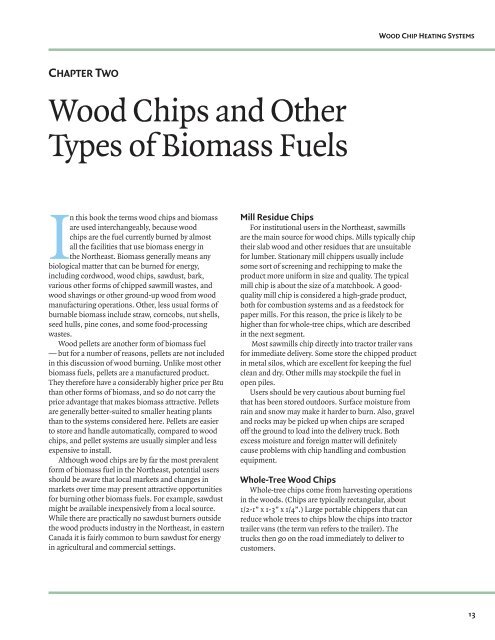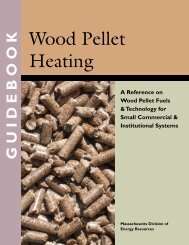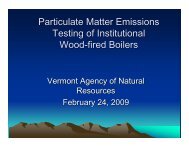Wood-Chip Heating Systems - Biomass Energy Resource Center
Wood-Chip Heating Systems - Biomass Energy Resource Center
Wood-Chip Heating Systems - Biomass Energy Resource Center
You also want an ePaper? Increase the reach of your titles
YUMPU automatically turns print PDFs into web optimized ePapers that Google loves.
CHAPTER TWO<br />
<strong>Wood</strong> <strong>Chip</strong>s and Other<br />
Types of <strong>Biomass</strong> Fuels<br />
In this book the terms wood chips and biomass<br />
are used interchangeably, because wood<br />
chips are the fuel currently burned by almost<br />
all the facilities that use biomass energy in<br />
the Northeast. <strong>Biomass</strong> generally means any<br />
biological matter that can be burned for energy,<br />
including cordwood, wood chips, sawdust, bark,<br />
various other forms of chipped sawmill wastes, and<br />
wood shavings or other ground-up wood from wood<br />
manufacturing operations. Other, less usual forms of<br />
burnable biomass include straw, corncobs, nut shells,<br />
seed hulls, pine cones, and some food-processing<br />
wastes.<br />
<strong>Wood</strong> pellets are another form of biomass fuel<br />
— but for a number of reasons, pellets are not included<br />
in this discussion of wood burning. Unlike most other<br />
biomass fuels, pellets are a manufactured product.<br />
They therefore have a considerably higher price per Btu<br />
than other forms of biomass, and so do not carry the<br />
price advantage that makes biomass attractive. Pellets<br />
are generally better-suited to smaller heating plants<br />
than to the systems considered here. Pellets are easier<br />
to store and handle automatically, compared to wood<br />
chips, and pellet systems are usually simpler and less<br />
expensive to install.<br />
Although wood chips are by far the most prevalent<br />
form of biomass fuel in the Northeast, potential users<br />
should be aware that local markets and changes in<br />
markets over time may present attractive opportunities<br />
for burning other biomass fuels. For example, sawdust<br />
might be available inexpensively from a local source.<br />
While there are practically no sawdust burners outside<br />
the wood products industry in the Northeast, in eastern<br />
Canada it is fairly common to burn sawdust for energy<br />
in agricultural and commercial settings.<br />
Mill Residue <strong>Chip</strong>s<br />
For institutional users in the Northeast, sawmills<br />
are the main source for wood chips. Mills typically chip<br />
their slab wood and other residues that are unsuitable<br />
for lumber. Stationary mill chippers usually include<br />
some sort of screening and rechipping to make the<br />
product more uniform in size and quality. The typical<br />
mill chip is about the size of a matchbook. A goodquality<br />
mill chip is considered a high-grade product,<br />
both for combustion systems and as a feedstock for<br />
paper mills. For this reason, the price is likely to be<br />
higher than for whole-tree chips, which are described<br />
in the next segment.<br />
Most sawmills chip directly into tractor trailer vans<br />
for immediate delivery. Some store the chipped product<br />
in metal silos, which are excellent for keeping the fuel<br />
clean and dry. Other mills may stockpile the fuel in<br />
open piles.<br />
Users should be very cautious about burning fuel<br />
that has been stored outdoors. Surface moisture from<br />
rain and snow may make it harder to burn. Also, gravel<br />
and rocks may be picked up when chips are scraped<br />
off the ground to load into the delivery truck. Both<br />
excess moisture and foreign matter will defi nitely<br />
cause problems with chip handling and combustion<br />
equipment.<br />
Whole-Tree <strong>Wood</strong> <strong>Chip</strong>s<br />
Whole-tree chips come from harvesting operations<br />
in the woods. (<strong>Chip</strong>s are typically rectangular, about<br />
1/2-1” x 1-3” x 1/4”.) Large portable chippers that can<br />
reduce whole trees to chips blow the chips into tractor<br />
trailer vans (the term van refers to the trailer). The<br />
trucks then go on the road immediately to deliver to<br />
customers.<br />
WOOD CHIP HEATING SYSTEMS<br />
13





